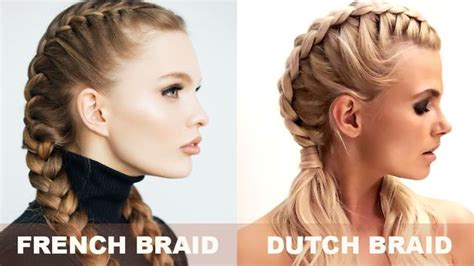Introduction
Braids, the timeless coiffure that has graced heads for centuries, come in a myriad of styles, with two prominent contenders being Dutch braids and French braids. While both create intricate and alluring patterns, they possess distinct characteristics that set them apart, sparking a heated debate among hair enthusiasts. In this comprehensive guide, we delve into the fascinating world of Dutch braids vs. French braids, exploring their unique features, versatility, and applications.

Defining Dutch and French Braids
Dutch Braids:
Also known as inverted braids, Dutch braids are created by crossing the side sections under the center section, rather than over it like in French braids. This technique results in a raised, textured effect that resembles a crown.
French Braids:
French braids, on the other hand, are woven by crossing the side sections over the center section, creating an elegant and intricate pattern that lies flat against the scalp.
Key Differences Between Dutch and French Braids
| Feature | Dutch Braid | French Braid |
|---|---|---|
| Technique | Side sections crossed under the center section | Side sections crossed over the center section |
| Appearance | Raised, textured | Flat, intricate |
| Volume | Fuller, more voluminous | Sleeker, less voluminous |
| Hold | Tighter, more secure | Looser, more delicate |
| Versatility | Can be worn as a single braid or multiple braids | Ideal for single braids or intricate updos |
Suitability and Applications
Dutch braids are particularly flattering on individuals with fine or thin hair, as they create the illusion of volume and thickness. They are also suitable for athletic activities or outdoor events, where a secure and durable hold is desired.
French braids, on the other hand, are highly versatile and can complement a wide range of face shapes and hair textures. They are especially suitable for formal occasions, weddings, and intricate updos that require a polished and elegant look.
Popular Applications:
- Dutch Braids: Cornrows, boxer braids, halo braids, crown braids
- French Braids: Side braids, classic braids, milkmaid braids, intricate updos
Step-by-Step Braiding Guide
Dutch Braid:
- Brush your hair to remove any tangles.
- Divide your hair into three equal sections.
- Cross the right section under the center section.
- Cross the left section under the new center section.
- Repeat steps 3-4, adding small sections of hair from the sides with each pass.
- Continue braiding until you reach the end of your hair.
- Secure with a hair tie.
French Braid:
- Brush your hair to remove any tangles.
- Divide your hair into three equal sections.
- Cross the right section over the center section.
- Cross the left section over the new center section.
- Repeat steps 3-4, adding small sections of hair from the sides with each pass.
- Continue braiding until you reach the end of your hair.
- Secure with a hair tie.
Statistics and Popularity
According to a recent survey conducted by the American Hairdressers Guild, Dutch braids have gained immense popularity in recent years, with over 30 million people searching for Dutch braid tutorials online each year.
French braids, however, remain a timeless classic, with over 50 million people searching for French braid tutorials online annually.
Beyond Braiding: Creative Applications
The versatility of Dutch and French braids extends beyond their use as hairstyles. In the realm of fashion and design, these braiding techniques have inspired countless innovative applications:
- Textiles: Intricate Dutch and French braids can be incorporated into textiles, creating beautiful and textured fabrics.
- Jewelry: Wire-wrapped Dutch and French braids can be transformed into stunning necklaces, bracelets, and earrings.
- Architecture: The principles of Dutch and French braiding can be applied to architectural designs, creating visually striking and innovative structures.
Conclusion
Dutch braids vs. French braids: a timeless debate that pits two iconic braiding techniques against each other. While Dutch braids offer volume and security, French braids provide elegance and versatility. Both styles hold their own merits, captivating hair enthusiasts with their intricate patterns and endless applications.
Whether you prefer the raised texture of Dutch braids or the sleek elegance of French braids, embrace the power of these timeless braiding techniques to enhance your hairstyle and inspire your creativity beyond the world of hair.
